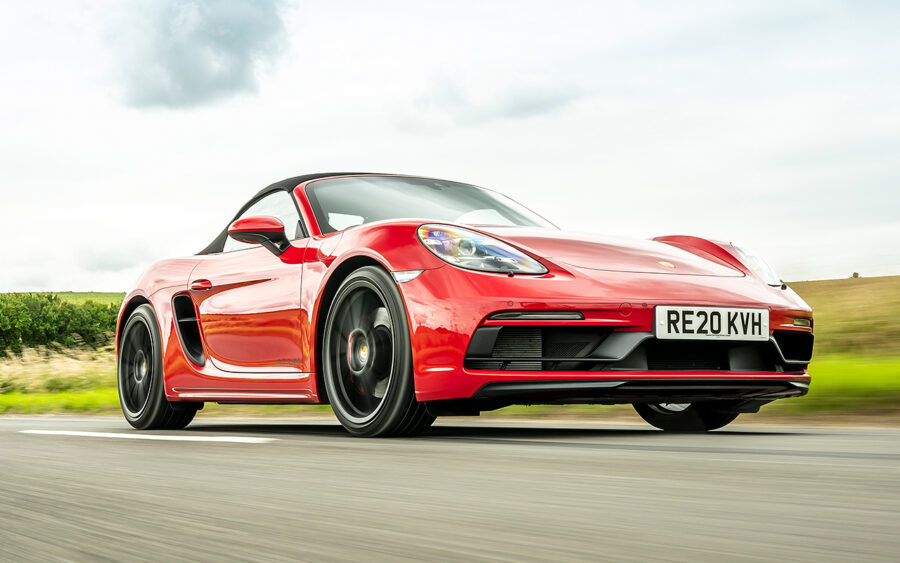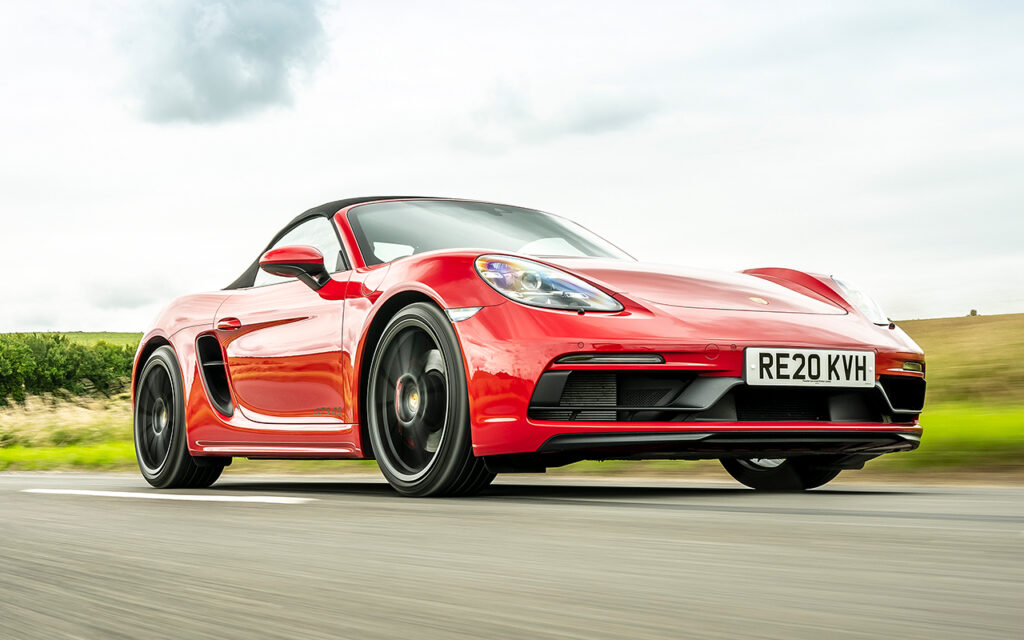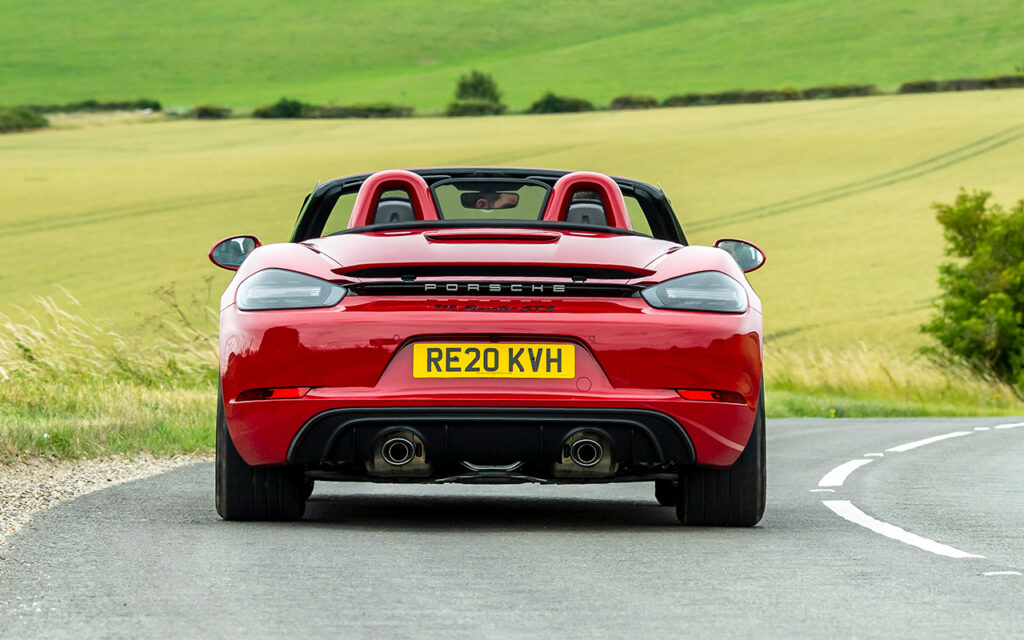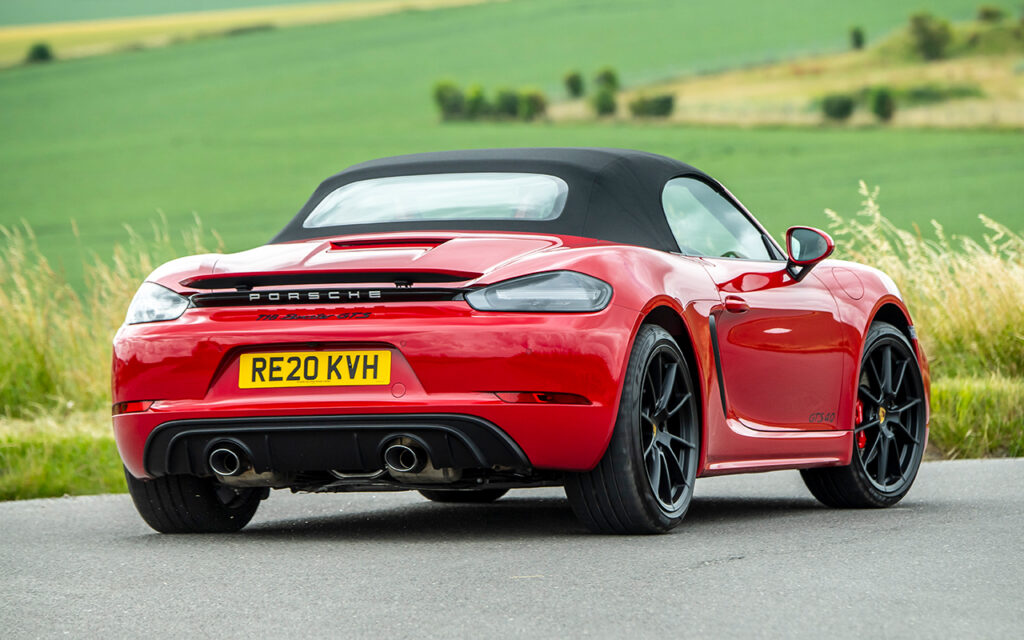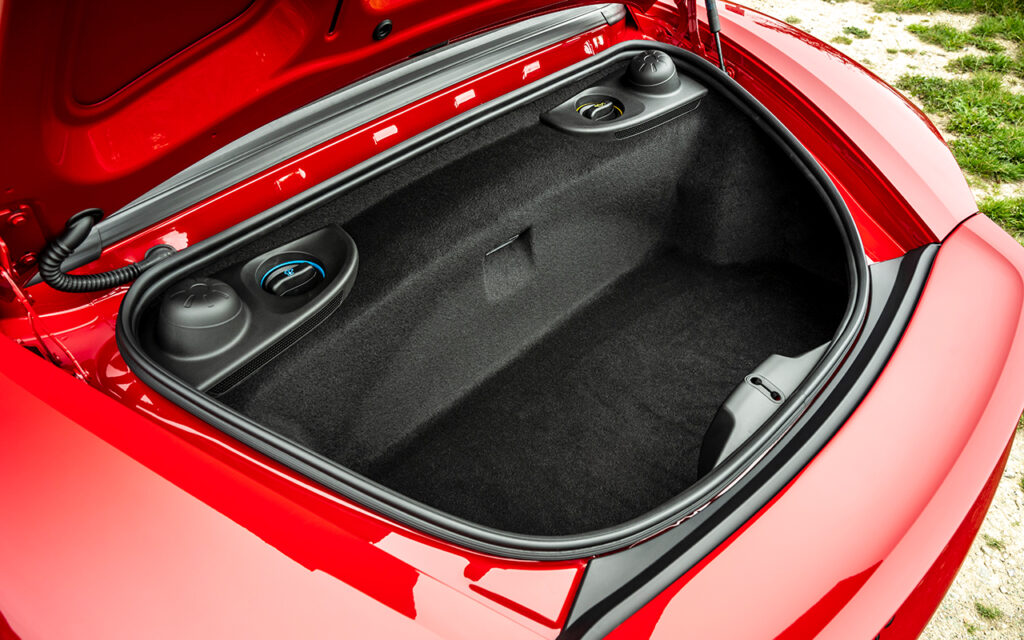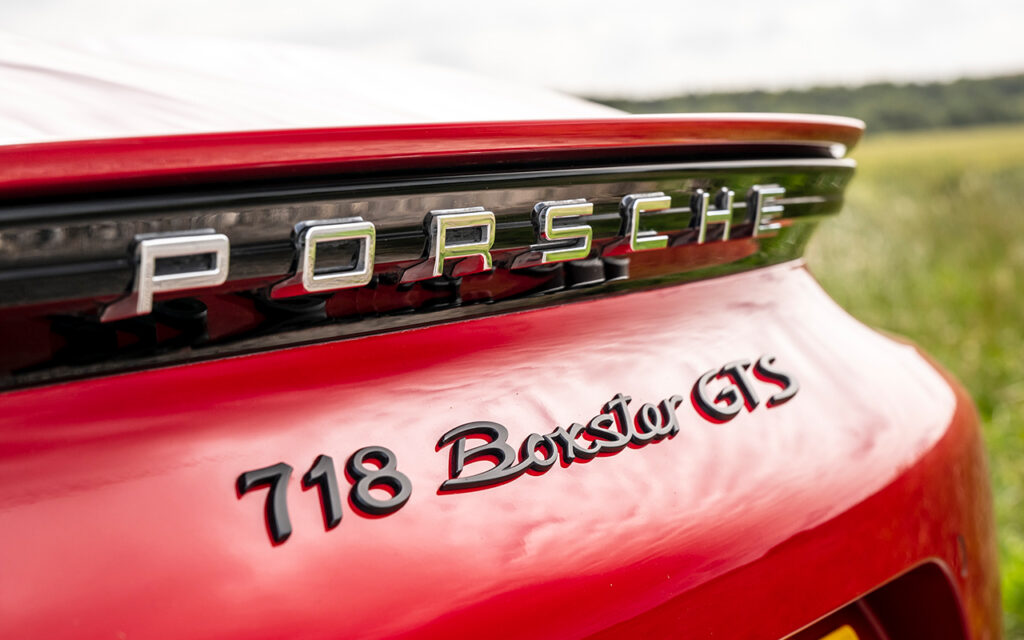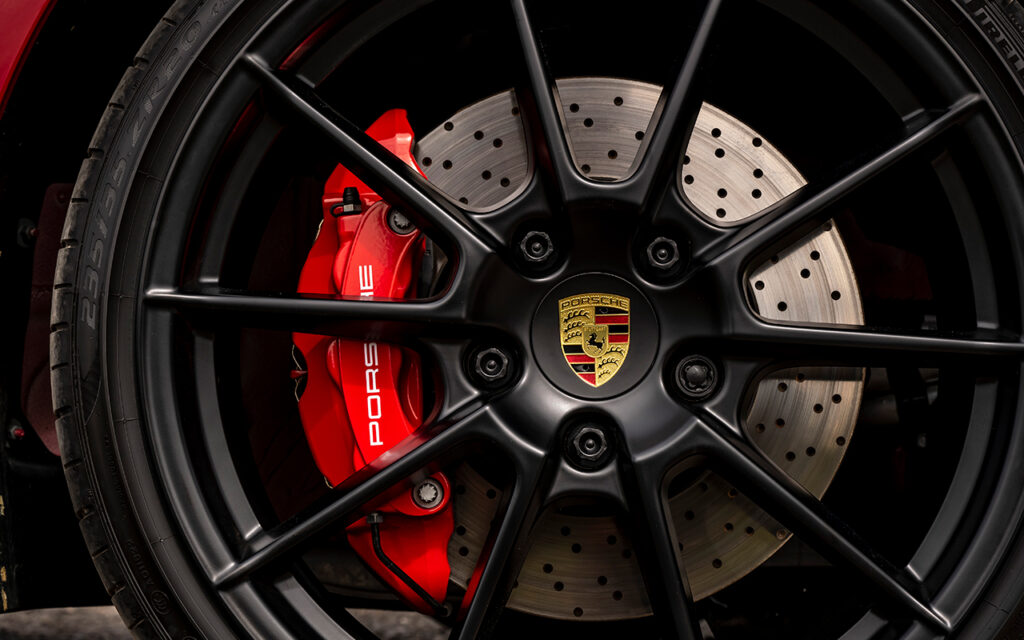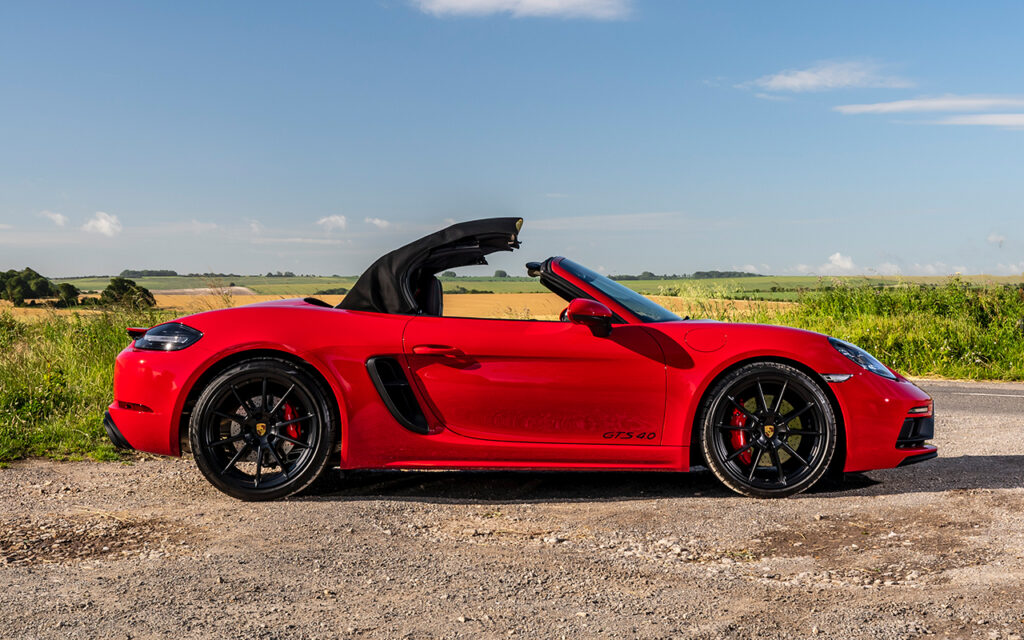The GTS 4.0 is perhaps the ultimate expression of standard 718 Boxster. Here’s what it’s like to drive
We’ve done this all wrong, right? Surely, as the Boxster turns the grand old age of twenty-five and matures into the magnificent GTS 4.0 (arguably the finest all-round package of the model to date), we really should have gone hopped into example loaded with a six-speed manual gearbox. Why did we pick a GTS 4.0 with seven-speed PDK? Tut, tut, P&PC. Tut, tut. Hang on a second. Have we really got it wrong? Is there actually more than meets the eye here? All in good time, folks. First, we need to talk about how good the 718 Boxster GTS 4.0 is, no matter which of its transmissions you opt for.
To start, let’s get the obvious out of the way: we’re sure there will be many of you smugly muttering “told you so” when we say the 718 is revitalised by the return to a naturally aspirated, flat-six engine, following the Boxster/Cayman’s flirtation with smaller-displacement four-cylinder turbocharged units. Honestly, it’s as though this is the powerplant the Boxster has always wanted! It feels so much more than what it is: the 9A2 Evo twin-turbo three-litre motor from the 992-generation 911 Carrera, stripped of its snail-shaped bhp boosters and then handily bored out to a 3,995cc capacity. Sure, there’s an argument it would have been simpler to take the four-litre MDG GA lump out of the old 991.2 GT3, but such a move would have been incredibly costly on Porsche’s part. And while you might be able to make more of an argument that the 718 Spyder ought to have a proper GT Department engine to justify its lofty status in model hierarchy, the car we’re playing with is only a GTS.
It can easily carry off the Carrera-derived four-litre engine, though, and without too much scrutinising of the powerplant’s exact technical make-up. Not that Porsche has detuned it far from Spyder specification, which serves up 414bhp. For the GTS 4.0, the sacrifice made is a mere nineteen ponies, the fierce flat-six churning out a fulsome 395bhp at 7,000rpm — that’s peak output delivered 600rpm lower than in the Spyder, which suggests a capping of the rev limit is the big difference.
Torque is the same, though: as is the case with the Spyder’s engine, the six-speed manual offers 310lb-ft at 5,000-6,500rpm, while the PDK is marginally more muscular at 317lb-ft (this thump arriving at 5,500rpm). The increased torque, coupled with the fact PDK offers launch control, means the dual-clutch GTS 4.0 has a number of other on-paper benefits: it’s considerably more accelerative, recording a 0-62mph run in exactly four seconds (as opposed to the manual’s 4.5-second sprint), while it’s still ahead in the sprint to 100mph from a standing start (8.7 seconds versus 9.2 seconds) and to 124mph from rest (13.7 seconds versus 14.1 seconds), although the pay-off for this extra poke doesn’t run as far at the top end, maxing at 179mph when the manual will romp to 182mph. The PDK GTS 4.0 is, however, greener – fuel economy of 28mpg coupled to 230g/km of CO2 emissions is better than the manual’s 26.4mpg and 246g/km. And, er, er… PDK offers more gears.
Actually, that last point isn’t as facetious as we’ve made it sound. It gives rise to one of the key benefits of the PDK option, relating specifically to the gearing: while the dual-clutch automated transmission adds 30kg to the kerb weight of the 718 Boxster GTS 4.0, not to mention another £2,303 to its asking price, choosing PDK might be worth absorbing these penalties for the fact the system lets you hear that magical engine sing slightly more often and in slightly less obviously law-breaking circumstances. You see, the manual GTS 4.0 is a peach of a car and its gearchange action is a short-shifting, mechanical delight, but the lever is connected to extraordinarily long cogs — at the top of second, the GTS 4.0 manual will be pulling 84mph. Click it into third, wind that mesmeric flat-six right out to the redline again, and you’ll be touching 120mph. Yes, really.
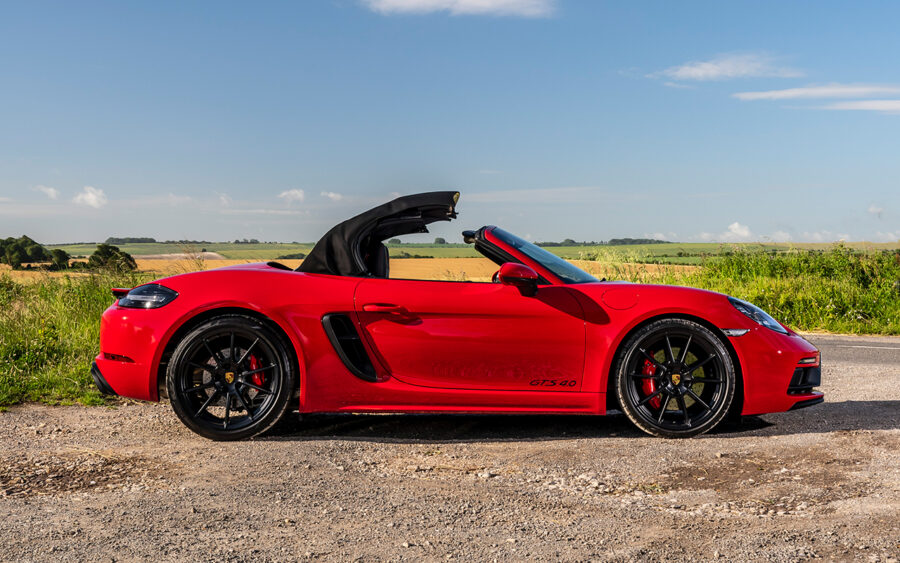
This is fantastic news for track fans looking forward to time in a Boxster GTS 4.0 on a circuit fast and flowing with high-commitment sections — we’re thinking Spa-Francorchamps as the ideal venue for these long-revving antics, with the Kemmel Straight towards Les Combes offering hooning heaven — but on the A43 past Silverstone, your options for redlining fun are severely limited, unless you want to incur the wrath of law enforcement agencies. This tall-geared trait is only exacerbated on a much more interesting road, where there’s enough muscle and reach to the four-litre engine that you could conceivably slot the manual GTS 4.0 into third and then just leave it there as you dissect all manner of corners, crests and cambers. And as the point of having three pedals in your footwell is to involve you more in the act of driving, the super-long gearbox seems like a missed opportunity.
To be fair, it’s not as if PDK swings entirely the other way and will rip up into fourth by motorway speeds. It won’t. It’ll still run beyond 70mph in second and into three figures in third, but there’s extra nuance about the driving experience brought about by having the additional ratio higher up the gearbox. It means that on give-and-take roads, the driver needs to put that tiny bit more thought into gear selection than is necessary in the manual. Granted, the actual mechanics of changing gears on the PDK are not as exciting as depressing a clutch pedal and stirring the joyous six-speed unit across its H-gate (the PDK is also hampered by having beautifully tactile metallic-feeling paddles on the steering wheel, but they’re about twenty percent too small), but there’s more mental stimulation in racing between second, third and fourth in PDK (when you’re having a back-road blast) than there is in the manual, where you just end up thumping it into, almost inevitably, third.
We need to mention another PDK benefit, which comes on routes you might not think ideally suited to a mid-engined masterpiece like the GTS 4.0: on the motorway, where the Porsche is surprisingly and supremely talented for a two-seat roadster — largely thanks to standard-fit Porsche Active Suspension Management (PASM), which gives a supple ride quality in the Normal setting — the PDK-equipped Boxster is a noticeably more relaxed cruiser. It sits at 2,400rpm at 70mph, whereas the manual is spinning away a little more busily at 2,800rpm. Granted, this is a small, incremental difference between the two transmission options, but if you’re judging the GTS 4.0 pairing rationally, inevitably, you begin to realise that maybe only a pair of pedals is best.
That said, judge the 718 Boxster GTS 4.0 with your heart and you’ll fall deeply, irrevocably and hopelessly in love with it, regardless of the cog swapper fitted. Seriously, we don’t think we’ve ever driven a finer Boxster model in a quarter of a century of trying. In truth, aside from the ridiculously rare and ridiculously expensive 991 Speedster, we don’t think we’ve ever driven a finer open-topped Porsche than this, period! Yep, the GTS 4.0 is most definitely preferable to the Spyder. The former offers all of the top tier car’s maniacal high-revs fireworks, but with a more usable roof, less track-focused (and therefore less spiky in the cold) tyres and with a marginally more attainable asking price. Put it this way, you can get hold of a 718 Boxster GTS 4.0 with whichever gearbox you like, straight out of the showroom, and it’ll set you back less than seventy grand. Even with a few choice options, you ought not to be spending past the £80k mark.
Aside from the gearing issue on the manual, which we could probably learn to live with, such is the effortless torque of the four-litre motor, its immaculately linear low-down throttle response and thoroughly decent soundtrack (even at sub-4,000rpm), the GTS 4.0 is as near faultless as any sports car is going to get. Think about it: this is a mid-engined, rear-wheel-drive roadster pumping out close to 400bhp from a naturally aspirated engine, with all of Porsche’s unrivalled chassis know-how poured into the mix. As you would expect, it’s completely sublime.
The delight starts as you climb into the 718’s cabin, which is a mix of the aging and the startlingly simple-to-understand. In an age of touchscreen climate controls and wholly digital, fully configurable TFT instrument clusters, there’s now a lot to be said for the Boxster’s mainly analogue dials, set of switches ahead of the gear lever (primarily for the heating and ventilation systems) and general ‘rightness’ of the ergonomics. True, the Porsche Communication Management (PCM) seven-inch touchscreen looks small in the dashboard, but it works fine, and everything feels superb. Besides, trust us when we say infotainment equipment is unquestionably not the star attraction in this particular car. Beyond this, there’s a great driving position to be achieved, though be aware most luxuries (much of the Alcantara trimming, for example) are cost options, as are eighteen-way Adaptive Sports Seats Plus with an accompanying memory package. They’re £2,096 and £1,991, respectively, in case you were wondering.
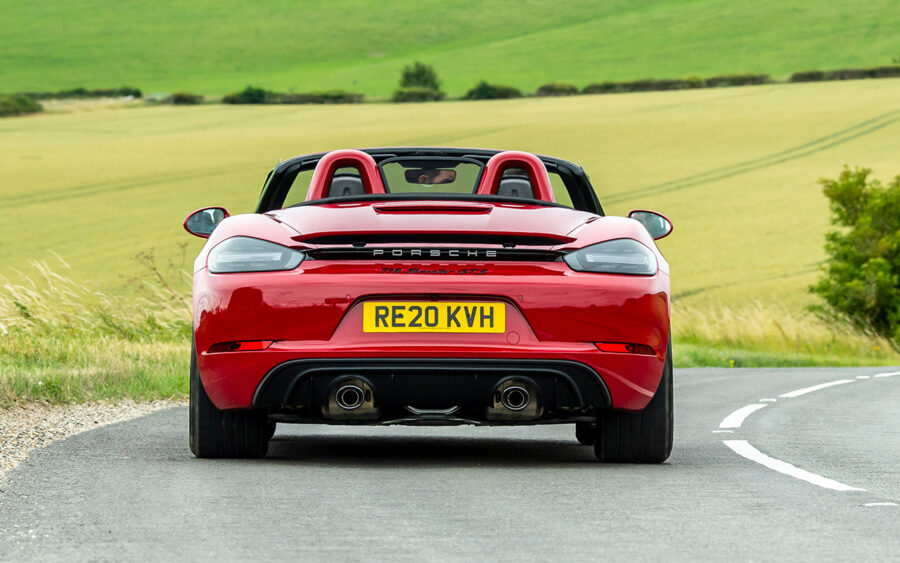
Porsche 718 Boxster GTS 4.0: on the road
Once you’re sat in your preferred position in the Porsche, you’re low down to the chassis, peeking over the top of the steering wheel and ensconced by the cabin architecture, but easily able to place the corners of the car in your peripheral vision. This superb visibility couples to the ease-of-use of the GTS 4.0, especially when in PDK trim (have we mentioned our love of this variant yet?!). It’s not an intimidating car to drive at city speeds, with wonderfully judged steering, progressive and sharp brakes, and smooth power delivery from the six-cylinder engine, but it’s also the ride quality and refinement that impresses.
The GTS 4.0 rolls on twenty-inch alloys with 35-profile tyres on both axles, yet the PASM, which is teamed to a ride height lowered by 20mm (when compared to other 718 Boxsters), does a fine job of smothering out most of the imperfections on a road when operating in Normal mode. The GTS 4.0 loses none of this civility as extra-urban speeds build, the model being just as good for covering long distance driving, with either hood up or down, delivering really relaxing, loping manners and the ability to turn in more than 30mpg.This, though, is mere bunce on top of the main dynamic deal, which is a quite exquisite chassis that the four-litre engine exploits as well as any of the turbocharged fours in the 718 family.
The same immediate turn-in of the front end is preserved, controlled by some of the best electromechanical steering in the business, and is totally unaffected by the increased mass of the bigger displacement engine. If anything, the Boxster feels better tied down than ever with its largest engine yet, in terms of swept capacity. The body and wheel control are off-the-charts good, while the playfulness of the rear axle is as inviting and as biddable as you could wish it to be. You can relax the electronic nannies in the 718 Boxster GTS 4.0 (or even switch them off completely) and the crisp finesse of the throttle pedal means the driver can precisely mete out the engine’s power to the rear wheels, allowing just the right degree of slip at corner exit.
Traction isn’t an issue either. Across ground, there will be few cars that are faster than a well-driven 718 Boxster GTS 4.0, and there will definitely be precious little else that will thoroughly involve and thrill its driver like this particular Porsche. It’s not that the four-cylinder Boxsters were actively bad — in fact, those turbocharged units had plenty of merits of their own, but we could always see the latent talent in the 982 chassis that was crying out for just a bit more Porsche oomph, and now that the 718 Boxster has it, we never want to let it go.
We’ve tried to assess the relative merits of the manual gearbox versus the PDK, and we hope we’ve given you whatever information you need to make the decision between two pedals or three in your GTS 4.0. The fact of the matter is that whichever transmission you opt for, what you get here is a coruscating, blinding, astounding bit of engineering. You also get solid proof that, even on its twenty-fifth anniversary, the Boxster has never been fitter — or finer — than this.

